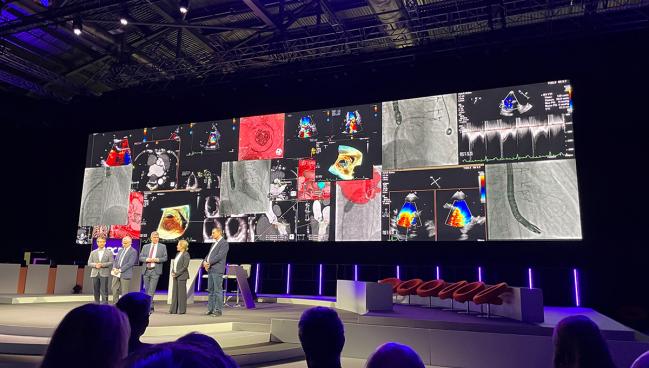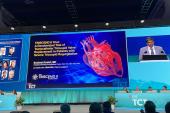For the Ideal Tricuspid TEER Patient—Look Beyond TRILUMINATE
Sicker, real-world patients derive similar symptom benefits from T-TEER: experts hope for an impact on harder outcomes, too.

LONDON, England—Many patients undergoing tricuspid transcatheter edge-to-edge repair (T-TEER) in the real world may bear little resemblance to those treated in the randomized TRILUMINATE trial, according to an analysis presented here at PCR London Valves 2023.
Lukas Stolz, MD (Ludwig-Maximilians-Universität München, Germany), who presented the study, said the findings support the value of T-TEER in patients with more comorbidities and more-advanced heart failure than those enrolled in the randomized trial, and also raise the tantalizing possibility that the hoped-for reduction in hard clinical endpoints not seen in TRILUMINATE might be seen in a more “unselected” patient population.
The study was published simultaneously in JACC: Cardiovascular Interventions.
Real-world TEER
As previously reported by TCTMD, TRILUMINATE using the TriClip (Abbott) showed that T-TEER improved quality of life in patients with severe tricuspid regurgitation (TR), but did not reduce heart failure hospitalizations or improve survival on top of optimal medical therapy. That has led to protracted debate as to the true valve of clip repair for TR: many observers have pointed out that symptom improvement and quality of life are what’s important to elderly patients, but others, given the large impacts of mitral TEER on mortality and hospitalizations in COAPT, had hoped to see more-dramatic benefits with T-TEER.
Stolz and colleagues set out to retrospectively apply the TRILUMINATE eligibility criteria to the patients who had undergone T-TEER at five large European heart centers and then compare outcomes between the types of patients who would or would not have been eligible for the randomized trial.
Between 2016 and 2022, 962 patients (mean age 78.3; 50% women) had T-TEER: of these, 54.8% were classified as TRILUMINATE-eligible, leaving almost half in the position of having undergone clip repair, but with disease characteristics that would have ruled them out for the randomized trial.
Compared with ineligible patients, eligible patients had less LV dysfunction and fewer comorbidities—in particular lower EuroSCORE II scores, better renal and kidney function, and better exercise capacity. Ineligible patients had notably higher diuretic use (and higher diuretic doses) and more heart failure hospitalizations in the prior 12 months: 76% versus 56%. In TRILUMINATE, just 25% of patients in both arms had been hospitalized for heart failure in the year prior.
For the quality-of-life endpoints that drove the benefit in TRILUMINATE, there were no differences between the real-world patients who would have met enrollment criteria for the randomized trial and those who would not: both groups experienced similar significant gains in NYHA functional class, 6-minute walk distance, and symptom questionnaire scores after T-TEER.
Reduction in TR was also no different between groups, with TR reduction to 2 or less achieved in 82% of trial-eligible patients and in 85% of ineligible patients, a nonsignificant difference. A TR reduction to 1 or less was seen in just 46.5% of eligible patients and 46.1% of ineligible patients, again a nonsignificant difference.
But while overall 1-year survival was 81% in the European cohort, survival rates differed significantly between trial-eligible and trial-ineligible patients (84.7% vs 74.9%; HR 1.71; 95% CI 1.27-2.30). By comparison, Stolz noted, 1-year survival for TEER-treated patients in TRILUMINATE was 90.6%.
Of note, in the observational cohort, survival curves continued to separate over 2- and 3-year follow-up for eligible versus ineligible patients—among the latter, those with two or more exclusion criteria had even worse survival.
Not surprisingly, hospitalizations for HF also were significantly higher in the TRILUMINATE-ineligible patients as compared with eligible patients: 22% vs 14% (P < 0.001). For the combined endpoint of survival free from tricuspid valve surgery, repeat tricuspid intervention, or heart failure hospitalization, rates in eligible and ineligible patients were 72.9% and 58.0%, respectively (P < 0.001).
In summary, said Stolz, “a significant proportion of patients undergoing T-TEER in everyday clinical practice are not [TRILUMINATE]-eligible, so we cannot directly [extrapolate] the results of TRILUMINATE to our patients. TRILUMINATE-eligible patients were considerably healthier with less-advanced HF and less comorbidities and while T-TEER was associated with comparable outcomes in softer clinical endpoints, 1-year mortality was 10% higher in TRILUMINATE-ineligible patients. These results may explain the lack of T-TEER efficacy for mortality and heart failure hospitalizations in the randomized TRILUMINATE trial.”
Takeaways for Practice and Trials
Following Stolz’s presentation, Mirjam Wild, MD (University Hospital of Freiburg/Herzzentrum Bad Krozingen, Germany), called it “an important analysis,” stressing that randomized trials face the dual aim of showing an impact on hard clinical outcomes and proving safety and technical feasibility.
“This is really reassuring that in this real-world cohort, the ineligible patient has a similar amount of TR reduction, symptomatic heart failure, and quality of life, so [that tells us] we can include these patients in the randomized trials without taking on the risk [of diluting] the results.”
In fact, Stolz and colleagues, including Jörg Hausleiter, MD (Klinikum der Universität München, Munich), senior author on this analysis, took these lessons in “sicker” patients to heart when designing their TRICI-HF trial launched last year. For TRICI-HF, said Stolz, “we have three mandatory inclusion criteria on top of the common ones: patients have to be hospitalized for heart failure within the 12 months before TEER, or they have to suffer from cardiohepatic syndrome or cardiorenal syndrome. That’s how we can ensure that we treat not only TRILUMINATE patients but also sicker ones like we are treating in real-world practice, but which have been excluded from [prior] trials.”
The trial will include a combined endpoint similar to the one in the TRILUMINATE trial, he continued, “so quality-of-life improvement with KCCQ, but also hospitalization for heart failure, and mortality, and we hope that we can also see an effect on heart failure hospitalizations, at least, or maybe even mortality.”
Francesco Saia, MD, PhD (IRCCS University Hospital of Bologna, Policlinico S. Orsola, Italy), speaking with TCTMD, described the ideal T-TEER patient as one who “is maybe sicker than in TRILUMINATE, but less advanced in the natural history of the disease.”
That means being more symptomatic, but without pulmonary hypertension and significant right ventricular (RV) remodeling, said Saia. “I think we have to focus on very symptomatic patients, but at an earlier stage of the disease, with optimal medical therapy, but without insisting too much on medical management,” Saia said. “There is always this idea that by increasing diuretics you can keep the patients healthy but in fact, we need to anticipate the intervention, too.”
Neil Fam, MD (University of Toronto/St. Michael’s Hospital, Canada), who was the top Canadian enroller for TRILUMINATE, agrees that by focusing on patients who did not have advanced symptoms, TRILUMINATE was unlikely to impact hard outcomes. In the November 2023 issue of EuroIntervention, Fam argues that TRILUMINATE patients were not enrolled too late for T-TEER to be of benefit, as some have suggested, but too early.
“We thought at the time that this would be the sweet spot, by treating people early,” Fam told TCTMD. TRILUMINATE proved that wrong, showing only benefits on symptoms and quality of life, not harder outcomes. Patients, said Fam, “are suffering, they're just not dying. And cardiologists are obsessed with death and heart failure, which matter. But quality of life matters as well. . . . These were healthy patients who were not that sick, they were all [NYHA] class II, so treating them medically didn't do harm—you didn't lose anything by treating them medically except quality of life.”
Payers, unlike patients, are less likely to be swayed by data showing an impact on quality of life and will want to see an impact on hard CV events, Fam predicted, noting that the US Food and Drug Administration is poised to review tricuspid devices in January 2024. For the sake of payers, enrolling a patient population at higher risk of death and heart failure hospitalizations, which might prove more likely to demonstrate a difference with T-TEER versus medical therapy, is the right next move, said Fam, particularly since medical therapy is not standardized in tricuspid disease, apart from diuretics.
“TRILUMINATE was an excellent first attempt at this, but the way I interpret TRILUMINATE is, using the device that they used in that population, which was not very sick, we don't affect hard outcomes, but patients feel better, which is fine,” said Fam. “But is society willing to pay $35,000 for patients to feel better? I don't know.”
Shelley Wood is the Editor-in-Chief of TCTMD and the Editorial Director at CRF. She did her undergraduate degree at McGill…
Read Full BioSources
Stolz L, Doldi PM, Kresoja KP, et al. Applying the TRILUMINATE eligibility criteria to real-world patients receiving tricuspid valve transcatheter edge-to-edge repair. J Am Coll Cardiol Intv. 2023;Epub ahead of print.
Disclosures
- Stolz reports receiving speaker honoraria from Edwards Lifesciences.





Comments